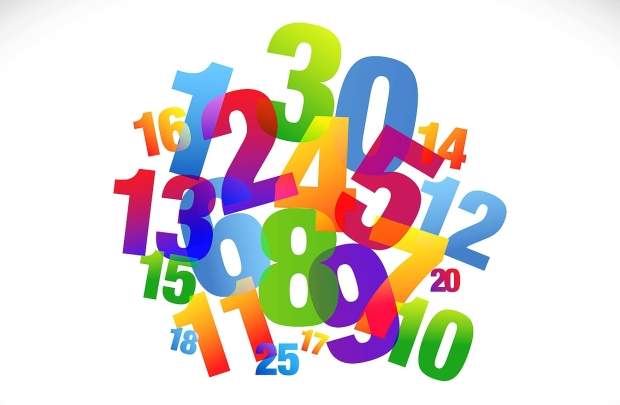How many? How big? How far? How long? And when should kids know what? From PBS, Learn and Grow has age-by-age tips, activities, and descriptions of what kids generally know and do from ages 2 to 8, in the fields of Creative Arts, Language, Literacy, Mathematics, Physical Health, Science, and Social and Emotional Growth.
There are – literally – hundreds of books aimed at introducing just-beginners to numbers; check out some good resources below.
Table of Contents
NUMBERS AND COUNTING
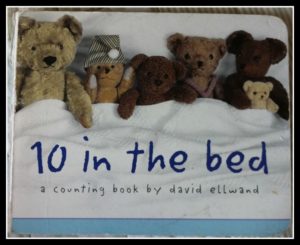 |
There are several picture-book versions of the loved-by-everybody song/nursery rhyme “Ten in the Bed:” “There were 10 in the bed and the little one said/”Roll over! Roll over!’/So they all rolled over and 1 fell out…” David Ellwand’s Ten in the Bed (Chronicle Books, 2001) is illustrated with enchanting photographs of ten teddy bears (including one in a striped night cap and one in wire-rimmed spectacles). For ages 1-4. |
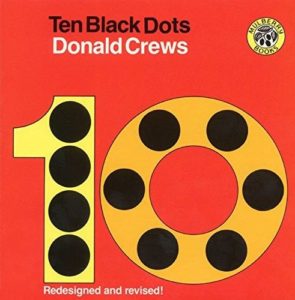 |
In Donald Crews’s rhyming Ten Black Dots (Greenwillow, 1994), various numbers of black dots (from 1 to 10) can be anything from a sun and a moon, to the eyes of a fox, the face of a snowman, or beads “for stringing on a lace.” Illustrated with big bright graphics for ages 1-5. |
| Math Literature Connections: Number Sense has activities and downloadable cards, worksheets and charts to accompany Donald Crews’s Ten Black Dots, Theo LeSieg’s Ten Apples Up on Top, and Jerrie Oughton’s How the Stars Fell Into the Sky. | |
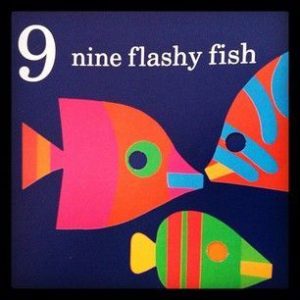 |
Lois Ehlert’s Fish Eyes (“A Book You Can Count On”) (Houghton Mifflin Harcourt, 1992), illustrated with gorgeous bright-colored fish, makes for a great interactive read, with many fish and fish eyes to count, plus shapes and colors to identify. For ages 2-5. |
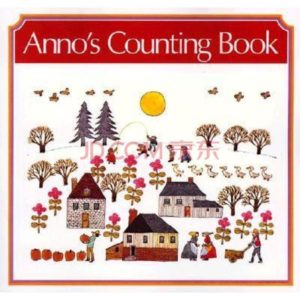 |
By Mitsumasa Anno, Anno’s Counting Book (Crowell, 1997) is an enchanting picture book that teaches the numbers 0 to 12 as a small village grows through the months of the year. The book opens with an empty snow scene (0); by 1, we have one house, one snowy pine tree, one bridge over the river, one snowman, and one skier; by 7, there are seven buildings, seven pine trees, seven spotted cows, a clothesline hung with seven sheets and, in the sky, a seven-colored rainbow. Delightful for ages 2-6. |
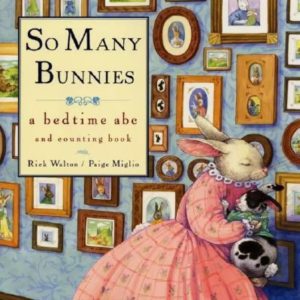 |
In Rick Walton’s rhyming So Many Bunnies (HarperFestival, 2000) – an ABC and counting book – Old Mother Rabbit, who lives in a shoe, is putting her 26 alphabetical offspring to bed, counting them one by one, from (1) Abel (who sleeps on a table) to (26) Zed, who sleeps in a shed. For ages 2-6. |
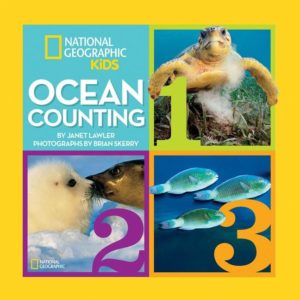 |
Janet Lawler’s Ocean Counting (National Geographic, 2013), illustrated with gorgeous color photographs, includes interesting “Did You Know?” fact boxes for each numerical group of ocean animals (starting with 1 green sea turtle). For ages 2-6. |
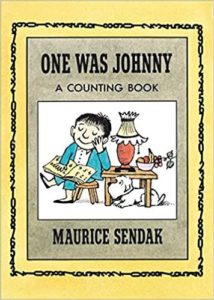 |
By Maurice Sendak, One Was Johnny (HarperCollins, 1991) begins with Johnny, who lives alone, happily reading by himself. Then a rat leaps in, followed by a cat, a dog, a turtle, and so on until an annoyed Johnny cleverly counts backwards, getting rid of his uninvited guests and restoring peace and quiet. For ages 2-7. |
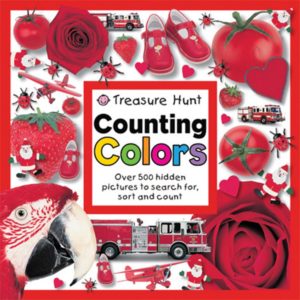 |
Roger Priddy’s Counting Colors (Priddy Books, 2007) groups bright photos of familiar objects by color. Each color-coded spread challenges readers to count to ten, by finding 1-10 different objects – for example, (red) 2 roses, 4 fire engines, and 9 strawberries or (yellow) 2 bananas, 6 chicks, 7 lemons, and 10 rubber ducks. For ages 2-6. |
| For many more resources, see Colors. | |
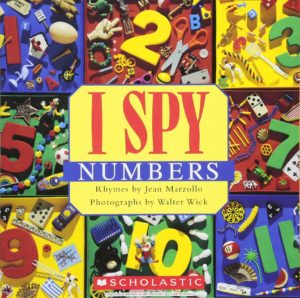 |
In Jean Marzollo’s I Spy Numbers (Scholastic, 2012) – illustrated with colorful photo spreads of appealing little objects – challenges readers to find numbers of items via little rhyming clues. Great for trips. For ages 3-5. |
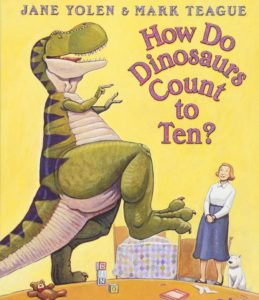 |
For dinosaur lovers, How Do Dinosaurs Count to Ten? by Jane Yolen and Marc Teague (Blue Sky Press, 2004) features enormous dinosaurs perched on kid-sized beds and playing with kid-sized toys. Readers count to 10 beginning with 1 tattered teddy bear. One of a series for ages 3-5. |
| Many more resources on Dinosaurs. | |
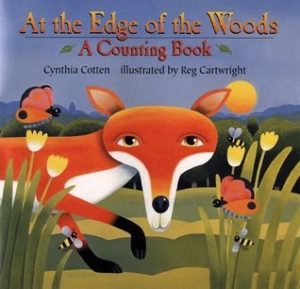 |
Cynthia Cotton’s At the Edge of the Woods (Henry Holt and Company, 2002) is a rhyming counting book of woodland animals, beginning with “At the edge of the woods, the grass grows tall/The daisies dance and the blackbirds call/One chipmunk lives in the old stone wall/At the edge of the deep, dark woods.” An evocative numerical read for ages 3-6. |
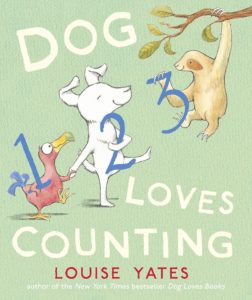 |
In Louise Yates’s Dog Loves Counting (Knopf Books for Young Readers, 2013), Dog has tried counting sheep, but still can’t get to sleep – so off he goes to find other animals to count. He begins with one baby dodo, and together the two of them set off in search of number three – a three-toed sloth, followed by a four-legged camel, a five-lined skink, and so on up to ten. At the end of the book, all ten animals end up counting stars. Other books featuring Dog include Dog Loves Books (2010) and Dog Loves Drawing (2012). For ages 3-6. |
| For many more resources, see WOOF: All About Dogs. | |
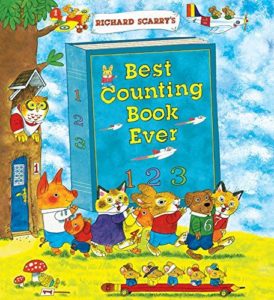 |
Richard Scarry’s Best Counting Book Ever (Sterling, 2010) counts by ones to twenty, then by tens to one hundred – all with Scarry’s busy little pictures in which there’s a lot to study and count. For ages 3-6. |
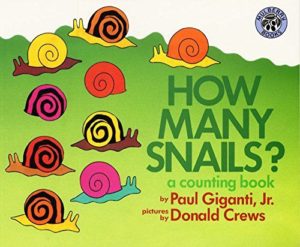 |
Paul Giganti’s How Many Snails? (Greenwillow, 1994) is a clever counting book that introduces kids to the idea of sets and subsets. (How many clouds? How many clouds are big and fluffy? How many clouds are big and fluffy and gray?) The School Library Journal trashed it for ambiguity (What constitutes a truck? Will kids know that fire trucks are trucks?) – but I think that’s a plus. Discuss and debate. That’s what books are for. For ages 3-7. |
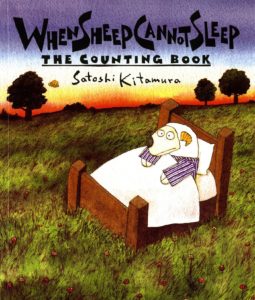 |
In Stioshi Kitamura’s When Sheep Cannot Sleep (Square Fish, 1988), Woolly, a pop-eyed little sheep in blue-and-white striped pajamas, can’t get to sleep – so off he goes for a walk, counting along the way, from one butterfly to two ladybugs, three owls, and four bats, up to 20 stars. Back in bed again, he thinks about his family – 21 relatives, all sheep – and so, finally, counting sheep, he falls asleep. Great watercolor illustrations. For ages 3-7. |
| Lots more on sheep! See resources here. | |
 |
We’re all primates! Anthony Browne’s One Gorilla (Candlewick, 2013) is a counting book of primates, from 1 gorilla to 2 orangutans, 3 chimpanzees, and so on, through gibbons, macaques, and mandrills to 10 ring-tailed lemurs. The book ends with 20 portraits of people (“All primates/All one family”). Illustrated with wonderful detailed paintings. For ages 3-7. |
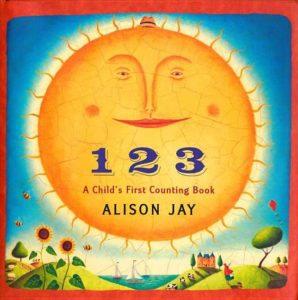 |
Alison Jay’s 1 2 3 (Dutton Juvenile Books, 2007) is a charmer, beginning with one sleeping little girl who is carried away on the back of a (golden-egg-laying) goose to an enchanting fairy-tale world, populated with three pigs, four frog princes, seven magic beans, and so on, up to ten and back again. Each wonderful illustration is filled with numbers and references to fairy tales. (Figure out which one.) For ages 4-7. |
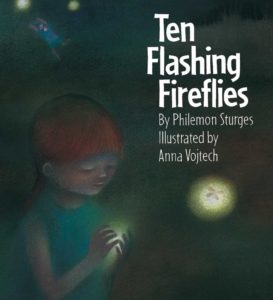 |
In Philemon Sturges’s Ten Flashing Fireflies (NorthSouth, 1997), a pair of children capture – one by one – ten fireflies in a jar, and then, as the lights begin to blink out, let them go (and glow) again, counting back down from 10 to 1. The illustrations are soft summer night scenes in pastels, with luminous balls of glowing fireflies. For ages 4-8. |
| Firefly Activities include making a wax-paper-winged fireflies, ice-cream-spoon fireflies, and a firefly keepsake jar. (Count them!) | |
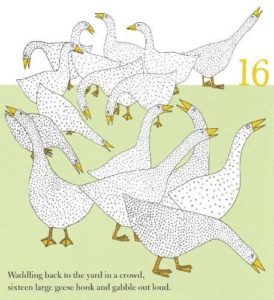 |
Alice Melvin’s Counting Birds (Tate, 2010), written in rhyming couplets, counts birds (1-20) over the course of a day, beginning at dawn with one cockerel, then two love birds in a cage, then three ducks. Readers learn 21 different birds (the book ends at evening, with one nocturnal barn owl.) For ages 4-8. |
| Many more resources on Birds. | |
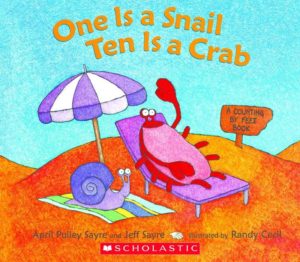 |
By April Pulley Sayre, One is a Snail, Ten is a Crab (Candlewick, 2008) is a counting book of feet, beginning with the one-footed snail – then 2 (people), 4 (dog), 6 (insect), 8 (spider), and 10 (crab). Odd numbers are represented by an even-footed animal plus one snail. The numbers 10 to 100 are then represented by various combinations of animals – 80, for example, can be eight crabs or ten spiders. Cheerful cartoon illustrations. For ages 4-8. |
| Check out the Parents’ Choice Six Best Counting Books. | |
| From The Best Children’s Books, see Learning Numbers with Counting Books. |
